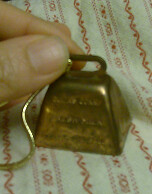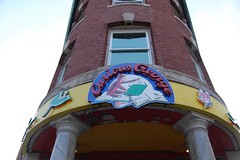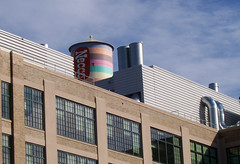Archive for the ‘nostalgia’ Category
Curious No More
After Harvard Square’s Wordsworth bookstore closed in 2004, owners Hillel Stavis and Donna Friedman decided to focus on their other venture, a children’s bookstore named after Curious George. They opened the store in 1995 with the consent of Cambridge resident Margret Rey who created George with her husband Hans. In addition to books they sold games and crafts. Well, you probably know where this is going. The owners announced earlier this month that the bookstore would close. Lease negotiations, healthcare costs, and the oft-cited bad economy contributed to their decision. They attempted to save Curious George and Friends by turning it into a non-profit and asking the Cambridge City Council and the Rey’s Curious George Foundation for help, proposing a small museum. But no one has stepped forward to save the store. Joining it in the disappearance of independent bookstores from the historic square is the Globe Corner Bookstore which closes this week.
MTA Memorabilia
The Metropolitan Transportation Authority (I could’ve just said MTA, right?) of New York sells a surprising collection of cast offs from public transportation. Right now they have subway car doors, line signs (with an optional cable so you can light ’em up), horns from the bottom of the subway car, and, don’t get too excited here: actual stanchion poles from inside the cars for $25 each (yes, the poles you hang onto, consider the possibilities but, like I said, don’t get too excited). Maybe you’d prefer a bus seat or a subway seat or those popular “Y cut” vintage subway tokens. It seems like everything that was nailed down can now be yours for a price.
Necco to Novartis
It’s been years since the sweet smell of the NECCO factory wafted across Cambridge, but I still missed that sugary air on my recent trip back. The Novartis Institutes for BioMedical Research (NIBR) took over the 1927 factory building after a $120 million transformation completed in 2004. The old candy factory that was sometimes referred to as Willy Wonka’s (I never saw anyone go in or out) now features two pairs of glass elevators like Charlie’s. The inside is completely transformed and the outside has been updated but had to conform to Cambridge’s strict hold over architectural improvements. In 1996, NECCO’s water tower was cleverly painted to resemble a stack of NECCO wafers. Novartis knew the iconic tower had to remain, but with a new identity. They sponsored a competition to solicit ideas from local artists and students. Joseph DePasquale won with a DNA double helix representing the company’s mission. A PowerPoint deck from Sponge Jet chronicles their careful restoration of the rusty tank with consideration for containment of the dust. The redone building may not emit a sweet smell (and considering the research going on inside we probably don’t want it to emit anything), but it retains some essence of the magical concoctions that it used to house.
Oh Are Ee Oh
Edible Geography takes a look at the history of the pattern on Oreo cookies and, actually, all embossed biscuits. The Oreo started out in 1912 with a wreath design, added turtledoves in 1924, and settled on today’s four-leaf clover and serrated-edge pattern in 1952. Of course as with any good old-fashioned American icon, there are conspiracy theories about its connection to the Freemasons.
Bells from Connecticut
 East Hampton, Connecticut was known as “Bell Town, USA” years ago when the town produced 90% of the world’s sleigh bells. The bell companies benefited from a law mandating that all sleighs, which run silent in the snow, use bells to warn pedestrians. With manufacturing shifted overseas, what’s left in East Hampton out of what used to be over 30 bell foundries is the proud sixth generation of the Bevin Brothers who’ve been making bells in Connecticut since 1832. If you’ve heard a Salvation Army bell ringer, you’ve heard a Bevin Brothers hand bell. The product line includes cow bells, mechanical door bells, prize fighter bells, and of course the classic sleigh bells. They say they’re the only company in the U.S. manufacturing just bells and they’ve stayed inventive by looking out for new business opportunities like supplying the bells for Poochie Pets (dog doorbells), another Connecticut company. I own a tiny Bevin Bill, pictured here (sorry for the fuzzy snapshot) which advertises Guida’s Milk, a New England dairy. It became our family “sick bell” for the bedside table and my mom handed it over to me when I was recovering from my c-section. Now that I’ve seen its model on the Bevin Brother’s website our little bell carries even more sentimental value. I think I better shine it up!
East Hampton, Connecticut was known as “Bell Town, USA” years ago when the town produced 90% of the world’s sleigh bells. The bell companies benefited from a law mandating that all sleighs, which run silent in the snow, use bells to warn pedestrians. With manufacturing shifted overseas, what’s left in East Hampton out of what used to be over 30 bell foundries is the proud sixth generation of the Bevin Brothers who’ve been making bells in Connecticut since 1832. If you’ve heard a Salvation Army bell ringer, you’ve heard a Bevin Brothers hand bell. The product line includes cow bells, mechanical door bells, prize fighter bells, and of course the classic sleigh bells. They say they’re the only company in the U.S. manufacturing just bells and they’ve stayed inventive by looking out for new business opportunities like supplying the bells for Poochie Pets (dog doorbells), another Connecticut company. I own a tiny Bevin Bill, pictured here (sorry for the fuzzy snapshot) which advertises Guida’s Milk, a New England dairy. It became our family “sick bell” for the bedside table and my mom handed it over to me when I was recovering from my c-section. Now that I’ve seen its model on the Bevin Brother’s website our little bell carries even more sentimental value. I think I better shine it up!
Retr0Bright
Not too long ago (I’m saying that so I don’t feel old) computers and their peripherals came in one choice of color and 99% of the time that was beige. Over the years, the beige ABS plastic turned yellow and even darker thanks to flame-retardant chemicals. A discovery from Commodore Amiga enthusiasts in Germany soon spread through the vintage computer community, reaching LifeHacker in 2009. Before and after photos of plastics treated with the hydrogen peroxide solution show startling results. Dubbed Retr0Bright, the formulas and background information are collected on a wiki. I stumbled upon this not in the context of whitening old computers, but looking into how to restore vintage Lego. My husband’s sister sent us her substantial collection of Lego (so large that most of it is still hidden in the garage awaiting good behavior reinforcement opportunities). Some of the white and clear pieces have yellowed over time, and while they are perfectly usable (except for the one I warped in the dishwasher), perhaps we’ll try restoring them to pristine condition one day.
Space Needle Bells
In researching the Seattle Center observation wheel, I discovered that when the Space Needle first opened for the World’s Fair it had a carillon that was played several times a day. The operator console was at the bottom of the Needle and visitors could observe the carillonneur. An automatic player roll could also be used. I haven’t found out when it was removed, but presumably today’s neighbors wouldn’t enjoy a return performance of the 538 bells.
What the Fluff
While researching nuances of New England dialect (more on that in the future perhaps) I came across “A List of Words That are Unique to New England.” It contains an entry for “Fluff-a-nutter” (which is really spelled fluffernutter, but since it’s pronounced with fewer ‘r’s in parts of Massachusetts I’ll let it go) and states that Marshmallow Fluff is a regional delicacy. I had no idea Fluff originated in New England. It was invented in Somerville, Massachusetts by Archibald Query in 1917. Marshmallow crème already existed at the time, but Query created an especially fluffy version in his kitchen and started selling it door-to-door. He sold the recipe for $500 to the Durkee-Mower company who expanded into retail and are still selling it today. In 1960 Durkee-Mower hired an advertising firm who concocted with great success and stickiness the name Fluffernutter for the Fluff and peanut butter sandwiches that had become a New England treat. In 2006 Somerville started celebrating an annual Fluff Festival (2010 site). Events include the crowning of the Fabulous Pharaoh of Fluff and, of course, a Fluff cooking contest with a grand prize of a private tour of the Durkee-Mower factory.
Pearl Harbor
Today at the commemoration of the 69th anniversary of the attack, the new Pearl Harbor Visitor’s Center will be dedicated. The overhaul of the center adds 6 acres of land, doubles the exhibition space in the museum, and improves the structural soundness of the building. The Visitor’s Center serves as the central entrance for four Pearl Harbor sites: USS Arizona Memorial, USS Bowfin Submarine Museum, USS Missouri Memorial, and Pacific Aviation Museum.
Silent Film
In the historic Niles district of Fremont, California the Niles Essanay Silent Film Museum preserves the memories of early movie days. The Essanay Film Manufacturing Company arrived in Niles in 1912. Having already produced 200 films, they settled in and made even more, including signing Charlie Chaplin for a year in 1914. Today the museum shows films on Saturdays, with traditional piano accompaniment. Museum historian David Kiehn was recently featured on “60 Minutes” for pinpointing the date of the “Trip Down Market Street” film to just days before the San Francisco earthquake in 1906.



